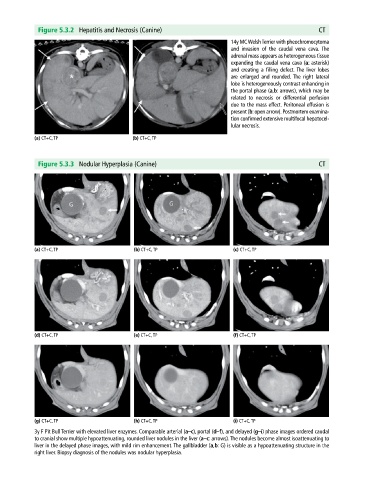Page 535 - Atlas of Small Animal CT and MRI
P. 535
Figure 5.3.2 Hepatitis and Necrosis (Canine) CT
14y MC Welsh Terrier with pheochromocytoma
and invasion of the caudal vena cava. The
adrenal mass appears as heterogeneous tissue
expanding the caudal vena cava (a: asterisk)
and creating a filling defect. The liver lobes
are enlarged and rounded. The right lateral
lobe is heterogeneously contrast enhancing in
the portal phase (a,b: arrows), which may be
related to necrosis or differential perfusion
due to the mass effect. Peritoneal effusion is
present (b: open arrow). Post mortem examina-
tion confirmed extensive multifocal hepatocel-
lular necrosis.
(a) CT+C, TP (b) CT+C, TP
Figure 5.3.3 Nodular Hyperplasia (Canine) CT
(a) CT+C, TP (b) CT+C, TP (c) CT+C, TP
(d) CT+C, TP (e) CT+C, TP (f) CT+C, TP
(g) CT+C, TP (h) CT+C, TP (i) CT+C, TP
3y F Pit Bull Terrier with elevated liver enzymes. Comparable arterial (a–c), portal (d–f), and delayed (g–i) phase images ordered caudal
to cranial show multiple hypoattenuating, rounded liver nodules in the liver (a–c: arrows). The nodules become almost isoattenuating to
liver in the delayed phase images, with mild rim enhancement. The gallbladder (a,b: G) is visible as a hypoattenuating structure in the
right liver. Biopsy diagnosis of the nodules was nodular hyperplasia.

